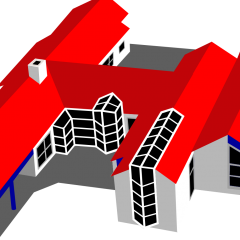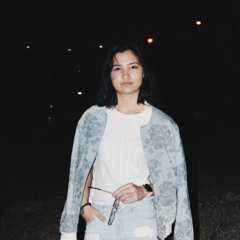Playhouse inspired by Gaudi...
<IMG BORDER=0 SRC="http://www.lonvig.dk/artblog-17-playhouse-square.jpg" ALT="artblog-17-playhouse-square (28k image)" HEIGHT=200 WIDTH=200 align="right" hspace="10">In my family you do not buy a playhouse.
You design it and you build it yourself.
This one is for Morten's daughters, Lucca and Laura.
Originally our plans were a playhouse with 6 walls - a hexagon.
And a tower, from which you have a wide view.
A gazebo.
Morten and I were a little relieved when some strong female influence made the plans less ambitious:
A four sided house with a chimney.
Morten and I decided, that the playhouse design should be based on the fantastic Spanish architect Antonio Gaudi's characteristically warped form - see about Gaudi below.
We have seen his work in Barcelona.
And.
Newly we had seen playhouses in Legoland,
see the article "<a href="http://www.lonvig.dk/art-news-artblog-15.htm">Hi sculptor...I mean you!!!</a>" for more about Legoland.
Lucca has decided the color scheme.
Yellow walls.
Red windows and door.
Green roof.
Her mother has decided the overall design criteria: <span style="font-weight:bold;">No spiders.</span>
<span style="font-weight:bold;">Action</span><br>I collected all the plates I had in stock in and around Lille Fejringhus and went to Hinnerup in Denmark, where Morten and his family live.
Hello, granddad.
Would you like some coffee?
Yes.
And we started drawing.
Four pressure-creosoted posts in the corners.
Tilting walls.
A floor that is elevated from the ground. Remember, no spiders.
Spade.
2 hammers
4 kinds of saws.
And many more tools.
Blood.
Sweat.
And very few tears.
Some days later the house was ready to paint.<br><br><br><IMG BORDER=0 SRC="http://www.lonvig.dk/artblog-17-north-east.jpg" ALT="artblog-17-north-east (27k image)" HEIGHT=200 WIDTH=162 hspace="10"><br clear=all><br>The shape of the windows are organic.
The windows are red.<br><br><br><IMG BORDER=0 SRC="http://www.lonvig.dk/artblog-17-east.jpg" ALT="artblog-17-east (29k image)" HEIGHT=172 WIDTH=200 hspace="10"><br clear=all><br>There is a shop in the playhouse.
There is a counter in one window.
You can buy a cup of excellent coffee,
candy and much more.
And take a look at the small house
on a post to the left of
the playhouse.<br><br><br><IMG BORDER=0 SRC="http://www.lonvig.dk/artblog-17-bird-house.jpg" ALT="artblog-17-bird-house (24k image)" HEIGHT=200 WIDTH=149 hspace="10"><br clear=all><br>It's a birdhouse.
Built by Morten's baby brother Jakob.
There is a triangular hole in the birdhouse.
A circular hole would have been
a non-Gaudi hole.
There is a perch with a bulb at the end.
That's sure a Gaudi-bulp and a Gaudi-perch.<br><br><br><IMG BORDER=0 SRC="http://www.lonvig.dk/artblog-17-south-east.jpg" ALT="artblog-17-south-east (33k image)" HEIGHT=200 WIDTH=157 hspace="10"><br clear=all><br>And a chimney.
Not a tall slim one.
I was drawing a draft of
a tall slim chimney.
Morten saw my draft and said,
No, no, no, no,
a small fat chimney.
A Gaudi-chimney.
Morten knows Gaudi better
than I do.
There is a huge metallic sculpture by the
motoway, just at the entrance to the city,
where I live.
Lucca calls this sculpture grandad's chimney.
After having struggled with building the
Gaudi-chimny, grandad's chimney has got a new meaning.
The roof has the characteristically warped shape.<br><br><br><IMG BORDER=0 SRC="http://www.lonvig.dk/artblog-17-south-south-east.jpg" ALT="artblog-17-south-south-east (26k image)" HEIGHT=200 WIDTH=151 hspace="10"><br clear=all><br>And the window in the gable
has a an exact Gaudi shape.
A shape Morten found in a book on
some of Gaudi's architecture.<br><br><br><IMG BORDER=0 SRC="http://www.lonvig.dk/artblog-17-north.jpg" ALT="artblog-17-north (26k image)" HEIGHT=200 WIDTH=141 hspace="10"><br clear=all><br>The house is number "5".
Lucca has painted this number herself.
Morten had a long discussion with Lucca
about where the number should be placed.
I agreed with Morten that it ought to be
placed on a post at the entrance to the
playhouse.
But Lucca insisted: On the gable
to the left of the door.<br><br><br><IMG BORDER=0 SRC="http://www.lonvig.dk/artblog-17-nort-north-west.jpg" ALT="artblog-17-north (26k image)" HEIGHT=200 WIDTH=141 hspace="10"><br clear=all><br>The door is a red ghost
with two eyes.
When your walls are tilted
and the door must be a Gaudi-door........
Many have asked Morten and I if we consider
to enter the business of designing, building and selling playhouses?
Of course not.
And.
Of course.....<br>
<span style="font-weight:bold;">Thoughts</span><br>How could Barcelona accept Gaudi's architecture and his characteristically warped form?
How could anyone?
Was his style les controversial in those days - Gothic Revival?
If Morten and I entered the "playhouse business" - it might be fun to let one particular great master's style be the point of departure, be the inspiration.
Why not build a Picasso-playhouse?
A Miro-playhouse?
A Matisse-playhouse?
Do you know the Austrian painter Hunderdwasser?
A Hundredwasser-playhous would be great fun.
And a Salvador Dali-playhouse?
__________________
<span style="font-weight:bold;">*) Antoni Gaudi</span>
Was born in Reus in Spain 1852.
The son of a coppersmith.
Antoni Gaudi was born in Reus, Spain in 1852.
Reus is not very far from Barcelona. In Barcelona you find his major art works.
He studied at the "Escola Superior d'Arquitectura" in Barcelona and designed his first major work for the Casa Vincens in Barcelona using a Gothic Revival style that he never left. Over the course of his career, Gaudi developed a sensuous, curving, almost surreal design style which established him as the innovative leader of the Spanish Art Nouveau movement. With little regard for formal order, he juxtaposed unrelated systems and altered established visual order. Gaudi's characteristically warped form of Gothic architecture drew admiration from other avant-garde artists.
Although categorized with the Art Nouveau, Gaudi created an entirely original style.
He died in Barcelona in 1926.
<span style="font-weight:bold;">Photos:</span> By Asbjorn Lonvig






0 Comments
Recommended Comments
There are no comments to display.
Create an account or sign in to comment
You need to be a member in order to leave a comment
Create an account
Sign up for a new account in our community. It's easy!
Register a new accountSign in
Already have an account? Sign in here.
Sign In Now